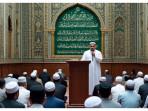UTBK SNBT 2025
15 Latihan Soal dan Kunci Jawaban UTBK SNBT 2025, Materi Tes Literasi Bahasa Inggris
15 contoh soal UTBK SNBT 2025 materi Tes Literasi Bahasa Inggris lengkap dengan kunci jawabannya
Editor: Nafis Abdulhakim
In the following article, the author speculates about a connection between the low-fat, high-carbohydrate diet recommended by the medical establishment in the last twenty years and the increasing rate of obesity among Americans.
American dietitians and members of the medical community have ridiculed low-carbohydrate diets as quackery for the past thirty years, while extolling a diet that cuts down on fat, limits meat consumption, and relies on carbohydrates as its staple. Many Americans are familiar with the food pyramid promoted by the U.S. government, with its foundation of carbohydrates such as breads, rice, and pasta, and its apex allotted to fats, oils, and sweets. Adhering to the government's anti-fat, pro-carbohydrate gospel, food manufacturers have pumped out fat-free grain products that lure consumers with the promise of leaner days. Then, why are Americans getting so fat? Could the dietary recommendations of the last twenty years be wrong? And what's more, could the proponents of diets that push protein and fat be right?
Fact: Obesity rates have soared throughout the country since the 1980s. The United States Centers of Disease Control reports that the number of obese adults has doubled in the last twenty years. The num-ber of obese children and teenagers has almost tripled, increasing 120 persen among African-American and Latino children and 50 % among white children. The risk for Type 2 diabetes, which is associated with obesity, has increased dramatically as well. Disturbingly, the disease now affects 25 % to
30 % of children, compared with 3 % to 5 % two decades ago.
What is behind this trend? Supersized portions, cheap fast food, and soft drinks combined with a sedentary lifestyle of TV watching or Internet surfing have most likely contributed to the rapid rise of obesity. Yet, there might be more to it: is it a coincidence that obesity rates increased in the last twenty years-the same time period in which the low-fat dietary doctrine has reigned? Before the 1980s, the conventional wisdom was that fat and protein created a feeling of satiation, so that overeating would be less likely. Carbohydrates, on the other hand, were regarded as a recipe for stoutness. This perception began to change after World War II when coronary heart disease reached near epidemic proportions among middle-aged men. A theory that dietary fat might increase cholesterol levels and, in turn, increase the risk of heart disease emerged in the 1950s and gained increasing acceptance by the late 1970s. In 1979, the focus of the food guidelines promoted by the United States Depart-ment of Agriculture (USDA) began to shift away from getting enough nutrients to avoiding excess fat, saturated fat, cholesterol, and sodium-the components believed to be linked to heart disease. The anti-fat credo was born.
To date, the studies that have tried to link dietary fat to increased risk of coronary heart disease have remained ambiguous. Studies have shown that cholesterol-lowering drugs help reduce the risk of heart disease, but whether a diet low in cholesterol can do the same is still questionable. While nutrition experts are debating whether a low-fat, carbohydrate-based diet is the healthiest diet for Americans, nearly all agree that the anti-fat message of the last twenty years has been over-simplified. For example, some fats and oils like those found in olive oil and nuts are beneficial to the heart and may deserve a larger propor-tion in the American diet than their place at the tip of the food pyra-mid indicates. Likewise, some carbohydrates that form the basis of the food pyramid, like the "refined" carbohydrates contained in white bread, pasta, and white rice, are metabolized in the body much the same way sweets are. According to one Harvard Medical School researcher, a breakfast of a bagel with low-fat cream cheese is "meta-bolically indistinguishable from a bowl of sugar."
So what about those high-fat, protein diets that restrict carbohy-drates like the popular Atkins' diet and others? A small group of nutrition experts within the medical establishment find it hard to ignore the anecdotal evidence that many lose weight successfully on these diets. They are arguing that those diets should not be dismissed out of hand, but researched and tested more closely. Still others fear that Ameri-cans, hungry to find a weight-loss regimen, may embrace a diet that has no long-term datal about whether it works or is safe. What is clear is that Americans are awaiting answers and in the meantime, we need to eat something.
7. The passage is primarily concerned with
A. questioning the dietary advice of the past two decades.
B. contrasting theories of good nutrition.
C. displaying the variety of ways one can interpret scientific evidence.
D. debunking the value of diets that restrict carbohydrates.
E. isolating the cause of the rising rate of obesity.
Jawaban: A
Pembahasan: The article raises the question, Could the dietary recommendations of the last twenty years be wrong? (lines 10-11).
The author's attitude toward the medical experts who ridiculed low-carbohydrate diets as quackery and praised low-fat diets is one of
A. bemused agreement.
B. seeming ambivalence.
C. unconcerned apathy.
D. implicit objection.
E. shocked disbelief.
Jawaban: D
Pembahasan: The author expresses her objection by depicting the medical experts as extreme, ridicul[ing] (line 2) one diet while extolling (line 3) another.
8. The term gospel as it is used in the passage most nearly means
A. one of the first four New Testament books.
B. a proven principle.
C. a message accepted as truth.
D. American evangelical music.
E. a singular interpretation.
Jawaban: C
Pembahasan: Choices a and d are alternate definitions that do not apply to the passage. The author uses gospel (line 8) with its religious implica-tions as an ironic statement, implying that scientists accepted a premise based on faith instead of on evidence.
9. The author uses the word Fact in order to
A. draw a conclusion about the USDA'S dietary recommendations.
B. imply that statistical information can be misleading.
C. hypothesize about the health effects of high-fat, protein diets.
D. introduce a theory about the increased rate of obesity.
E. emphasize a statistical reality regardless of its cause.
Jawaban: E
Pembahasan: The author begins with Fact (line 14) to introduce and highlight statistical information. She or he does not speculate about the meaning of the statistics until the next paragraph.
10. The passage suggests that the obesity trend in the United States is
A. partly a result of inactive lifestyles.
B. the predictable outcome of cutting down on saturated fat.
C. a cyclical event that happens every twenty years.
D. unrelated to a rise in diabetes cases.
E. the unfortunate byproduct of the effort to reduce heart disease.
Jawaban: A
Pembahasan: The author names a sedentary lifestyle of TV watching and Internet surfing (lines 24-25) as a contributing factor to the rise in obesity rates.
11. In lines 26-31, the author implies that the government's 1979 food guidelines
A. relied more on folk wisdom than on scientific study.
B. was based on the theoretical premise that eating less dietary fat reduces heart disease.
C. was negligent in not responding to the increasing incidence of heart disease.
D. no longer bothered to mention nutrient objectives.
E. was successful in reducing heart disease rates.
Jawaban: B
Pembahasan: The passage suggests that the 1979 dietary guidelines responded to a theory that dietary fat (line 34) increases heart disease.
12. The author characterizes the anti-fat message of the last twenty years as
A. elusive.
B. questionable.
C. incoherent.
D. beneficial.
E. inventive.
Jawaban: B
Pembahasan: The passage describes the anti-fat message as oversimplified (lines 48-49) and goes on to cite the importance of certain beneficial types of fat found in olive oil and nuts (lines 38-39).
The author cites the example of a breakfast of a bagel with low-fat cream cheese in order to
A. show that getting a nutritional breakfast can be fast and convenient.
B. demonstrate that carbohydrates are the ideal nutrient.
C. overturn the notion that a carbohydrate-based breakfast is necessarily healthy.
D. persuade readers that they should eat eggs and sausage for breakfast.
E. argue that Americans should greatly restrict their carbohydrate intake.
Jawaban: C
Pembahasan: This example supports the claim that the body uses refined carbo-hydrates in much the same way (lines 42-43) that it does sweets.
13. The author of the passage would most likely agree with which statement?
A. The federal government knowingly gave the public misleading advice.
B. Soaring obesity rates are most certainly a result of low-fat diets.
C. Nutritionists should promote high-fat, protein diets like the Atkin's diet.
D. Scientists should investigate every fad diet with equal scrutiny.
E. There is no definitive evidence connecting dietary fat to heart disease.
Jawaban: E
Pembahasan: Lines 42-43 support this statement.
14. The tone of the last sentence of the passage is one of
A. optimism.
B. resolve.
C. indulgece.
D. irony.
E. revulsion.
Jawaban: D
Pembahasan: The last sentence is ironic-it expresses an incongruity between conflicting dietary advice that targets different types of food as unhealthy, and the reality that humans need to eat.
15. Read the text and answer the question!
Earthquake is any sudden shaking of the ground caused by the passage of seismic waves through Earth's rocks. Seismic waves are produced when some form of energy stored in Earth's crust is suddenly released, usually when masses of rock straining against one another suddenly fracture and "slip." Earthquakes occur most often along geologic faults, narrow zones where rock masses move in relation to one another. The major fault lines of the world are located at the fringes of the huge tectonic plates that make up Earth's crust.
Little was understood about earthquakes until the emergence of seismology at the beginning of the 20th century. Seismology, which involves the scientific study of all aspects of earthquakes, has yielded answers to such long-standing questions as why and how earthquakes occur. About 50,000 earthquakes large enough to be noticed without the aid of instruments occur annually over the entire Earth. Of these, approximately 100 are of sufficient size to produce substantial damage if their centers are near areas of habitation. Very great earthquakes occur on average about once per year. Over the centuries they have been responsible for millions of deaths and an incalculable amount of damage to property.
What will happen when seismic waves pass through Earth's rocks?
A. It will answer why and how earthquakes occur.
B. It may cause an earthquake.
C. It will store some form of energy in Earth's crust.
D. The masses of rock will slip.
E. It may produce seismic waves.
Jawaban: B
Pembahasan:
Soal tersebut menanyakan hal yang akan terjadi ketika gelombang seismik melewati batuan bumi.
Informasi tentang gelombang seismik dapat ditemukan dalam paragraf pertama. Dikatakan bahwa gempa bumi 'adalah setiap guncangan tiba-tiba dari tanah yang disebabkan oleh lewatnya gelombang seismik melalui batuan bumi.' Berdasarkan pendefinisian tersebut, dapat disimpulkan bahwa jika lempengan bumi menerima gelombang seismik, gempa bumi akan terjadi.
Jadi, pilihan jawaban yang tepat adalah B.
(TribunTrends.com/TribunMedan)
Sumber: Tribun Medan
| 20 Latihan Soal Lengkap dengan Kunci Jawaban Materi Kemampuan Penalaran Umum UTBK SNBT 2025 |

|
|---|
| Contoh Soal UTBK SNBT 2025 Materi Penalaran Umum, Lengkap dengan Kunci Jawaban dan Pembahasannya |

|
|---|
| 30 Contoh Soal Lengkap dengan Kunci Jawaban Materi TPS, Bahan Belajar UTBK SNBT 2025 |

|
|---|
| 30 Latihan Soal TPS dan Lengkap dengan Kunci Jawaban, Persiapan Seleksi UTBK SNBT 2025 |

|
|---|
| Latihan Soal Lengkap dengan Kunci Jawaban Materi Pemahaman Bacaan dan Menulis UTBK SNBT 2025 |

|
|---|





